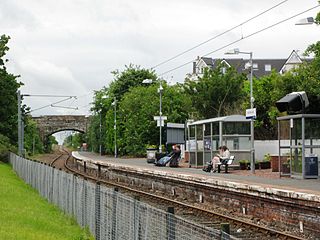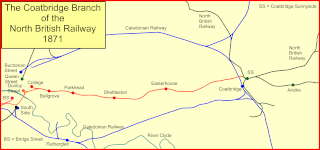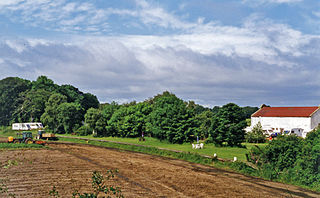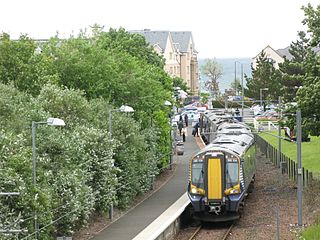
The North British Railway was a British railway company, based in Edinburgh, Scotland. It was established in 1844, with the intention of linking with English railways at Berwick. The line opened in 1846, and from the outset the company followed a policy of expanding its geographical area, and competing with the Caledonian Railway in particular. In doing so it committed huge sums of money, and incurred shareholder disapproval that resulted in two chairmen leaving the company.

Longniddry railway station is located at the southeast corner of the village of Longniddry, East Lothian, Scotland. The station is on the East Coast Main Line, 13+1⁄4 miles (21.3 km) east of Edinburgh Waverley, and is served by stopping passenger trains on the North Berwick Line.

Drem railway station serves the village of Drem in East Lothian, 5 miles (8 km) from the seaside town of North Berwick in Scotland. It is located on the East Coast Main Line (ECML) 18 miles (29 km) east of Edinburgh Waverley. Passenger services are provided on the ScotRail North Berwick Line, and the junction where the North Berwick branch diverges from the ECML is a short distance to the east of the station.

North Berwick railway station is a railway station serving the seaside town of North Berwick in East Lothian, Scotland. It is the terminus of the Edinburgh to North Berwick Line, 22+1⁄4 miles (35.8 km) east of Edinburgh Waverley.

The Coatbridge Branch of the North British Railway was a railway built to connect the important coal and iron industrial districts of Coatbridge and Airdrie directly to Glasgow for the North British Railway.

Aberlady railway station served the village of Aberlady in Scotland. It was served by the Aberlady, Gullane and North Berwick railway. This line diverged from the East Coast Main Line at Aberlady Junction, east of the current Longniddry station.
Williamstown railway station was a railway station on the North Berwick Branch of the North British Railway in East Lothian, Scotland. This short-lived station was the temporary terminus of the branch line from Drem. The station was named after a nearby farm, the modern spelling of which is Williamstone.

Dirleton railway station was a railway station on the North Berwick Branch of the North British Railway in East Lothian, Scotland. It was an intermediate station on the branch line from Drem.

The North Berwick Branch is a short railway branch line built by the North British Railway to connect North Berwick, in East Lothian, Scotland to the East Coast Main Line. It was built as a tactical means of excluding competitors from the area, and when it opened in 1850 it was loss making. The later development of North Berwick as a resort and a golfing centre transformed the branch line.
Gullane railway station served the village of Gullane in Scotland. It was served by the Aberlady, Gullane and North Berwick railway. This line diverged from the North British Railway Main Line at Aberlady Junction, east of the current Longniddry station.
Luffness Platform served a golf course near Gullane in Scotland. It was served by the Aberlady, Gullane and North Berwick railway. This line diverged from the North British Railway Main Line at Aberlady Junction, east of the current Longniddry station. For the private use of members of the Luffness Golf Club, this unstaffed halt was opened in 1898 and closed in 1932. Passengers alighting had to inform the train guard at Gullane or Aberlady and passengers joining the train there had to request it to stop by hand signals.
The Duns Branch and the Berwickshire Railway together formed a through railway route from Reston, near Berwick-upon-Tweed, to St Boswells in the Scottish Borders. The line was promoted in two stages. The first was from Reston on the Edinburgh to Berwick main line to Duns ; it opened by the North British Railway in 1849.
The Haddington line was a branch railway line connecting the Burgh of Haddington to the main line railway network at Longniddry. It was the first branch line of the North British Railway, and opened in 1846. Road competition severely hit passenger carryings in the 1930s, and the line closed to passengers in 1949. Coal and agricultural goods traffic continued, but the line closed completely in 1968.
The Peebles Railway was a railway company that built a line connecting the town of Peebles in Peeblesshire, Scotland, with Edinburgh. It opened on 4 July 1855, and it worked its own trains.
The Lauder Light Railway was a railway line opened in 1901 to connect the remote agricultural settlement of Lauder in Berwickshire with the main line of the Waverley Route railway at Fountainhall. Traffic was never heavy and bus competition led to closure to passengers in 1932. Goods traffic might not have survived but a Food Buffer Depot was established at Lauder during World War II and the rail-borne traffic sustained the line for some years. It closed finally in 1958 and little now remains, though bits of the formation, including embankments and cuttings, are visible at Middletoun.
The East Fife Central Railway was a mineral railway line in Fife, Scotland, that ran from near Leven to Lochty. It was intended to develop extensive coal measures in the area, but in fact they proved to be uneconomic. The line was completed by the North British Railway and it opened in 1898.
The St Andrews Railway was an independent railway company, founded in 1851 to build a railway branch line from the university town of St Andrews, in Fife, Scotland, to the nearby main line railway. It opened in 1852. When the Tay Rail Bridge opened in 1878 residential travel to Dundee was encouraged.
The Fife Coast Railway was a railway line running round the southern and eastern part of the county of Fife, in Scotland. It was built in stages by four railway companies:
The History of the North British Railway until 1855 traces the founding and construction of the railway company. It built and opened its line between Edinburgh and Berwick and formed part of the first rail link between Edinburgh and London. The line opened in 1846.








